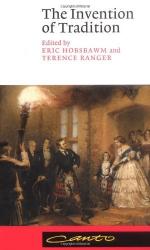|
This section contains 498 words (approx. 2 pages at 400 words per page) |

|
Chapter 1, Introduction, Inventing Traditions Summary and Analysis
In Chapter 1, author Eric Hobsbawm, analyzes his concept of 'invented tradition' which includes those traditions invented, constructed, and formally instituted which are tied to false histories and have contemporary origins. The overtly or tacitly accepted rules that make up a tradition have a ritual or symbolic nature that imbue certain values and norms through repetition and try to establish continuity with the past. Yet this continuity is fictitious. The apparent continuity is produced in the human mind by repetition of ritual.
Hobsbawm distinguishes traditions from customs. Traditions imply invariance, whereas customs allow more fluctuation. Traditions are also distinct from routines; routines have no ritual or symbolic function of significance. These routines, while invented, have a technical rather than ideological function; thus, they are not invented traditions. Inventing of tradition involves formalization and ritualization with reference...
(read more from the Chapter 1, Introduction, Inventing Traditions Summary)
|
This section contains 498 words (approx. 2 pages at 400 words per page) |

|




